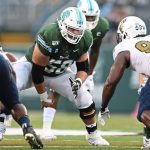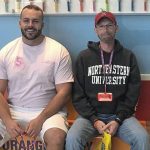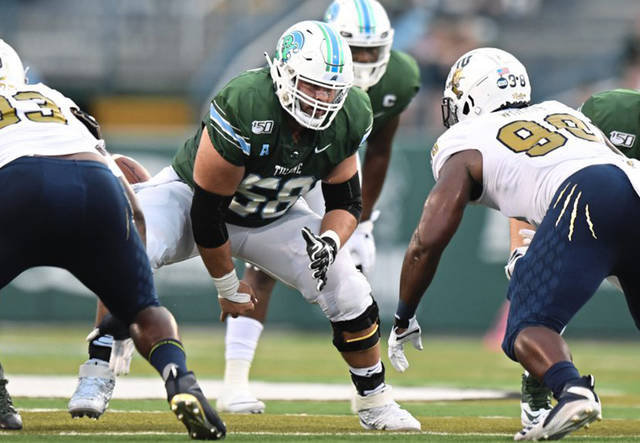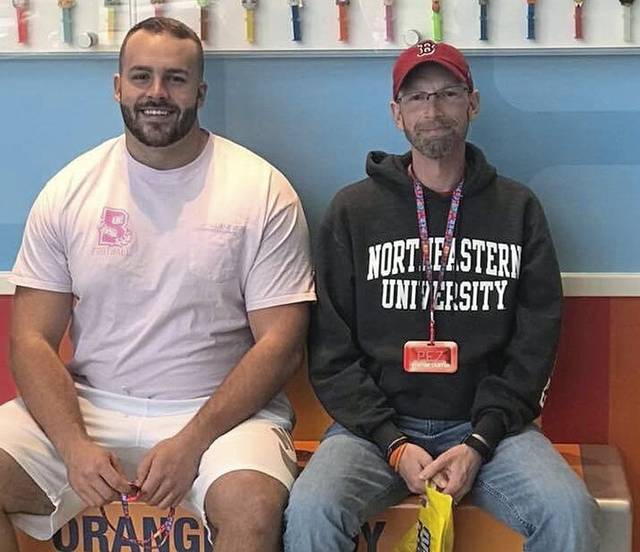How a Steelers rookie saved the life of someone he never even met


Share this post:
It was probably just a spam call. Christian Montano saw a New York area code on his phone that he didn’t recognize.
Now a Steelers rookie free agent, Montano was in his apartment near Tulane’s campus when the phone rang. The offensive lineman was anticipating his grad transfer year with the Green Wave.
Before Montano hit ignore, he remembered what the date was: Feb. 2, 2019. It was a year — plus one day — after the procedure.
Montano guessed who might be on the other end of the line. He was given a heads up that a call may be coming soon.
This wasn’t going to be a robot with a prerecorded message or a shyster trying to scam him.
It was the person Montano never knew. The person who may not be alive without him. The guy Montano could only refer to as “recipient” up until now.
As soon as Montano answered that call, all these months and years after the process began, this person would have a voice. A story. And a name.
The only reason this call was coming to Montano’s phone was because he accepted a different call about 15 months earlier.
He was home in Connecticut for Thanksgiving after his academic senior season at Brown had just concluded.
“This is the Rhode Island Blood Center,” the voice on the other end told Montano. “We work with the ‘Be The Match’ organization. We think you are a potential match for someone.”
By February, after numerous follow-up tests, Montano was under anesthesia at the Dana-Farber Cancer Institute in Boston. A needle was in his back — the rear part of his pelvic bone — extracting 1,300 milliliters of bone marrow for a person he never met.
Someone so anonymous Montano couldn’t identify him if his life depended on it.
That person’s life depended on Montano, though. And he was going to save it.
Whether they knew each other or not.
Montano downplayed what he called “the drama television” of the procedure, saying it only made him slightly nervous. But he called it “a breeze to go through.”
“If the opportunity came, and they said I was the best match, I was certainly going to go forward with it,” Montano said Wednesday.
Freshman year.
It’s just something Brown’s first-year players do. It’s a program then-head coach Phil Estes adopted from Villanova’s Andy Talley.
You go into lecture halls. You convince students to get their cheeks swabbed for “Be The Match” as they cross the quad leaving class. You volunteer to get yourself swabbed as well.
Community outreach. Campus interaction. That sort of thing.
Unless you’re Montano. And you’ve lost three grandparents to cancer. Then you aren’t just showing up to get swabbed to fulfill an obligation and look good for the coach.
You are showing up hoping you get selected.
“Christian was the first to volunteer,” Estes said. “When he found out he was a match, he didn’t hesitate. He was there to save a life.
“Probably the most giving, nicest human being you are ever going to meet. One of the hardest working kids we’ve ever had in the program.”
After a trip to the restroom over Labor Day weekend of 2017, Jim Calhoun (no relation to the former UConn basketball coach) was washing his hands and passed out. On the way down, he hit his head on a granite countertop.
When he got checked out near his home in Saratoga Springs, N.Y., it was determined that Calhoun — now 46 years old — was suffering from acute lymphoblastic leukemia. He had the adult form of a disease most commonly present in children. It was determined that a bone marrow transplant was necessary to save his life. That’s when his doctors in New York sent him to Dana-Farber.
Calhoun has three sisters. None were acceptable donor candidates.
Fortunately for Calhoun, he was still in the 70%-75% range of potentially finding a donor.
Even more fortunately for Calhoun, a few years before his diagnosis, a football player with a big heart and bigger ax to grind against cancer got his cheek swabbed, and his DNA was put in the registry.
[gps-image name=”2602068_web1_ptr-MontanoCalhoun-050120.jpg”]
The meetings in Dr. Corey Cutler’s office at Dana-Farber often get emotional. Some people cry. So he always has a box of tissues available.
That comes in handy for other reasons. Like explaining what’s happening in the patient’s body.
“I show them the UPC code on the bottom,” Cutler explained. “That’s an identifier for that box of Kleenex. You have a scanner at your grocery store. And it knows it’s a box of Kleenex and it’s $1.99.
“Our immune system has the same barcode system. Every cell in our body carries a barcode that defines us as ‘self’ vs ‘non-self.’ That bar code is comprised of these six genes that we match for on the sixth chromosome. The HLA genes. You get one set of six from your mother. You get one set of six from your father. That gives you 12 genes to match.’”
Complicated though that may sound (even with the visual aid), the bottom line is that Calhoun and Montano matched on all 12 genes that are tested for transplant compatibility.
So in February 2018, Montano went to Dana-Farber for the donation procedure, still blind to the identity of the person who would get his DNA.
“All I knew was that it was a male in his 40s,” Montano said. “I was nervous for him.
“You see the people while you are walking around Dana-Farber. They are so sick. Fighting cancer. And I’m going to be able to help one of these people. Maybe it’s one of the people in a room here. Maybe it’s someone across the world.”
The rules of anonymity are a big deal in the transplant world when it comes to this match program. Those who specialize in the field have come to the conclusion that when donors and recipients get to know each other, sometimes complications occur.
Sometimes those issues take place getting to know the person before the procedure, and a fallout happens. Sometimes after the procedure — if a recipient’s body doesn’t accept the donation — the donor is devastated by a feeling of failure.
So you stay silent. And you wait.
You wait through the procedure. And you even wait a year after to see if the transplant is fully successful. In the end, Calhoun says only 25% of recipients end up meeting their donors.
Even Cutler couldn’t know who Montano was. Another physician had to extract the marrow from Montano.
Technically, he was Calhoun’s physician, so that would have been deemed as a conflict of interest.
“What if we were three quarters of the way through the procedure and Christian started to have a problem?” Cutler asked. “Do I stop now? Do I need to protect Christian? Or do I say, ‘Since Jim is my patient, keep going because Jim needs a little bit more?’
“This way the person who did the extraction — if Christian is having a problem — that doctor is going to stop (immediately).”
To this day, Cutler says he has never met Montano.
It was a year after the transplant. You’d think this would be the easy chapter.
After all, Calhoun had already conquered the hard part. His immune system was essentially destroyed on purpose. Shots through the blood-brain barrier to the spine in New York. In Boston, heavy doses of radiation and chemotherapy to weaken his immune system so it could more readily accept the marrow from Montano.
Calhoun would be the same on the outside. The same in his mind. The same in his heart. But the cells pumping through his body belonged to a man he never met.
“Everything in my system right now is Christian,” Calhoun laughed. “My DNA. My blood type. I’m all what Christian is.”
Sounds like that’s pretty good thing, actually.
“The majority of leukemia, when it comes back after transplant, happens within the first year. Jim is well beyond that,” Cutler said. “We are hoping that Jim is cured. That’s a word we use in transplantation. For most people who deal with cancer and chemotherapy, they talk about remission. But with Jim and transplant, we are talking about ‘cure.’ The longer he goes from transplant, the more likely he is to actually be cured.”
Surviving that physical and mental taxation is pretty tough, though. So why was a phone call to Montano so hard?
Obviously, he wanted to do it. He sought the approval to track down Montano. He was so excited he was trying to reach out the first day he was allowed. Just dial!
Not so easy.
“I paced my house for three hours. I was just too emotional,” Calhoun said. ”But once I got on the phone with him, I felt like I knew him forever.”
Montano answered.
“Is this Christian Montano?” the voice asked.
“Yes,” Christian replied.
“This is Jim Calhoun. I’m your bone marrow recipient.”
Now “recipient” became “Jim.” A husband to Karin. A father of two (Jenna, 26 and Zachary, 22) that are roughly Montano’s age. A football fan. A guy who couldn’t wait to pass the phone to his family so they could thank Christian for keeping their husband and dad alive.
“To hear that voice … it was special. He was so appreciative. I didn’t want to be thanked. I just wanted to help someone. It was amazing,” Montano recalled.
The call would wind up being easy by comparison.
In early May 2019, Montano’s family in Connecticut invited Calhoun’s family down from Saratoga Springs so everyone could meet for the first time.
“I pulled up his street. I had to turn around and go grab my thoughts,” Calhoun remembered. “So I went to a parking lot. How do I thank him? He gave me a second chance at life.”
Calhoun gathered his courage and the two families that will forever be bonded all got to embrace for the first time.
“I just remember giving him a big hug as soon as I saw him,” Montano recalled. “We have a lot of things in common. We both love dogs. We both love sports.”
Calhoun went so far as to describe Montano as his younger brother. Montano says, in a way, it’s like having another uncle and a twin at the same time.
One of the medical side effects of the procedure is that sometimes patients can’t produce tears. According to Calhoun, he may have been the only one present who wasn’t shedding any.
Although he wanted to.
West Point isn’t very far from Saratoga Springs. Tulane was playing Army during Montano’s final season this past fall.
Tulane made Calhoun — a member of the Army Reserves — an honorary captain for the game against the Black Knights, so he could reunite with Montano on the field.
Tulane may not have a massive fan base in Upstate New York. But because of Montano’s presence, Calhoun was the president of it.
And it sounds like he’ll be making a little room for some black and gold in his closet, too.
“I jumped for joy,” Calhoun said upon hearing that Montano signed with the Steelers. “I can’t wait to go down to Pittsburgh and watch.”
Covid-19 is shortening the offseason program. Preseason games may be shaved. A crowded depth chart along the offensive line already exists for the Steelers.
When it comes to making the roster, that may be a more complicated match for Montano than the barcode on the bottom of a tissue box.
But no match will ever be as important as the one Montano has already made with Calhoun.



